1. Introduction: The Four Hottest Smart Speakers of 2018 Are Here!
Every year in the tech world, new trends emerge. Ten years ago, it was smartphones; eight years ago, tablets; four years ago, wearable devices; two years ago, artificial intelligence. This year, without a doubt, it is the smart speaker that has taken the world by storm—especially in China.
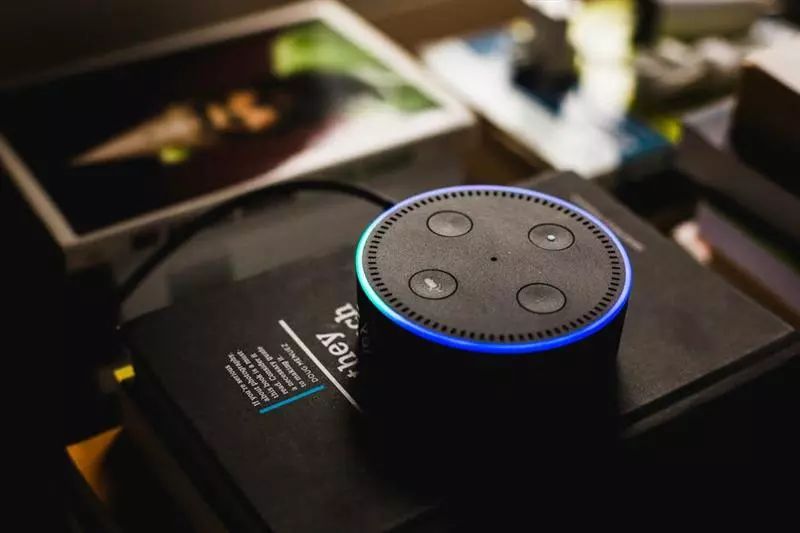
According to market research firm Canalys, global smart speaker shipments in Q1 2018 increased by 200%, with China’s smart speaker market experiencing an astonishing growth rate of 5370%, reaching 1.8 million units shipped, making China the second-largest smart speaker market in the world after the United States.
The development of smart speakers in China can be described as rapid. Before 2017, the concept of smart speakers did not exist domestically, but within a year, the domestic market accelerated, with major players like BAT (Baidu, Alibaba, Tencent) rushing in, leading to a plethora of products and eventually resulting in the first smart speaker in China to exceed one million units in sales.
As the prices of smart speakers have dropped below 1000 yuan, the question for consumers has shifted from “Should I buy a smart speaker?” to “Which smart speaker should I buy?”
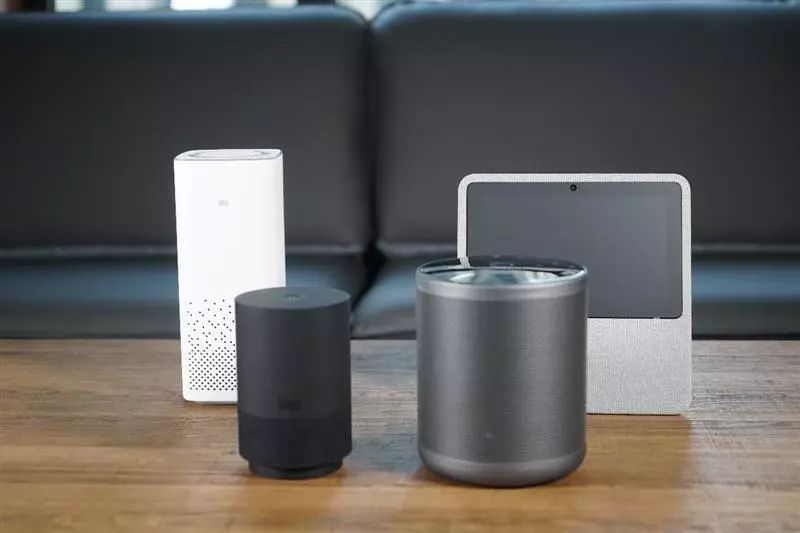
To find the answer to this question, we have gathered the four hottest smart speaker products currently on the market: TMall Genie X1, Xiao Bao AI Speaker, Xiaomi AI Speaker, and Baidu’s Home. Let’s see which one is more suitable for you.

2. Appearance Comparison: 3 Plastic, 1 Metal; Xiao Bao AI Speaker Stands Out
TMall Genie X1, Xiao Bao AI Speaker, and Xiaomi AI Speaker all adopt the traditional cylindrical speaker design, while Baidu’s Home features a tablet-like shape due to its additional screen.

From left to right are TMall Genie X1, Xiaomi AI Speaker, Xiao Bao AI Speaker, and Baidu’s Home. Comparing the designs, there are significant differences in specific details among the four speakers.
Among them, TMall Genie X1 is the smallest, and its solid color design makes it the most understated among the four speakers, which is beneficial as it does not stand out too much in the home.
The Xiaomi AI Speaker is the tallest among the four, and its dotted design on the lower half makes it look very similar to another Xiaomi product—the Xiaomi Air Purifier.
As for the Xiao Bao AI Speaker, it features a very standard cylindrical shape, with a rounded design reminiscent of the classic Mac Pro “trash can”.
Regarding Baidu’s Home, due to the additional screen, its front adopts a square design, with the upper half housing the screen and the lower half covered by a fabric mesh speaker.
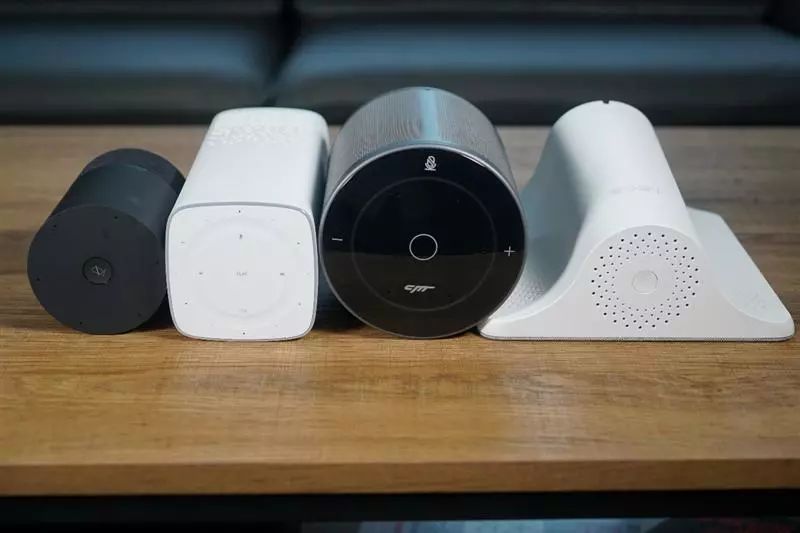
Top view of the four speakers.
To facilitate user operation, all four speakers have their operational areas located on the top. TMall Genie X1 and Baidu’s Home only support tap operations; the Xiaomi AI Speaker adds swipe operations (for adjusting volume); the Xiao Bao AI Speaker supports gesture operations.
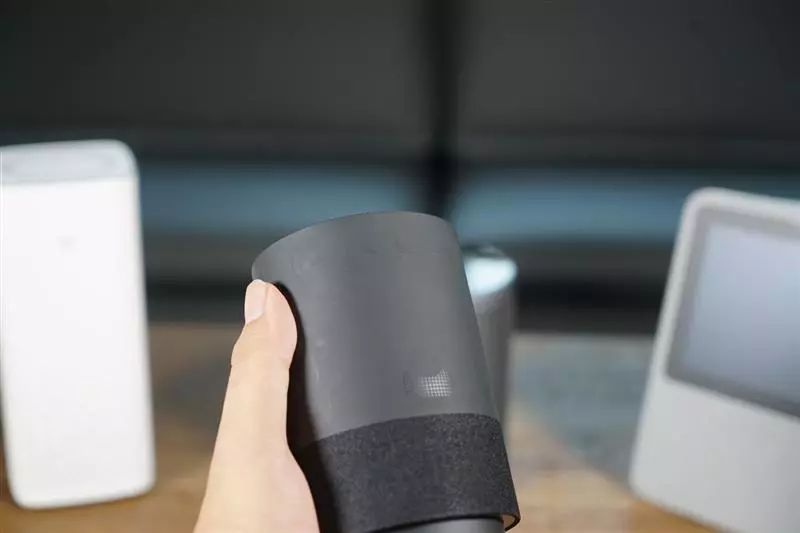
Details of TMall Genie X1 feature a spliced design, with the upper half made of frosted plastic and the lower half covered by a dust mesh for the speaker, with a dot matrix pattern TMall logo in the middle.
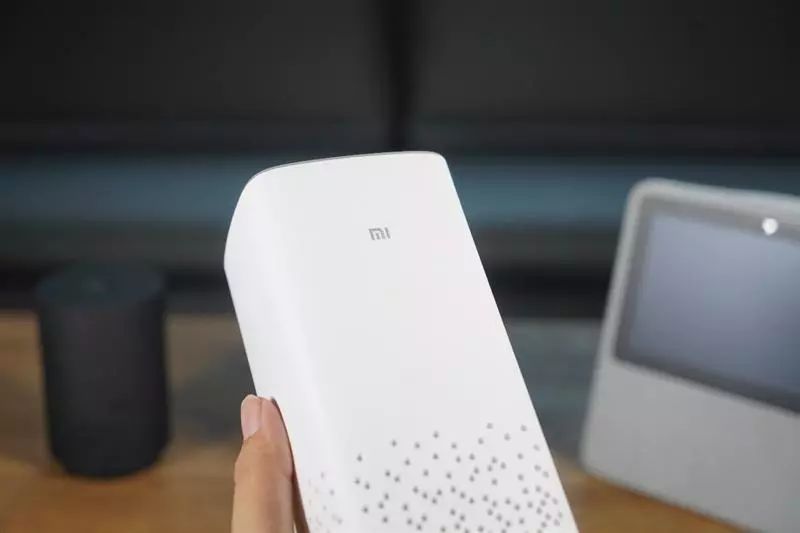
Xiaomi AI Speaker features a very simple plastic body design, with only a dot matrix sound hole and a small Xiaomi logo on the front, almost like a mini version of the Xiaomi air purifier.
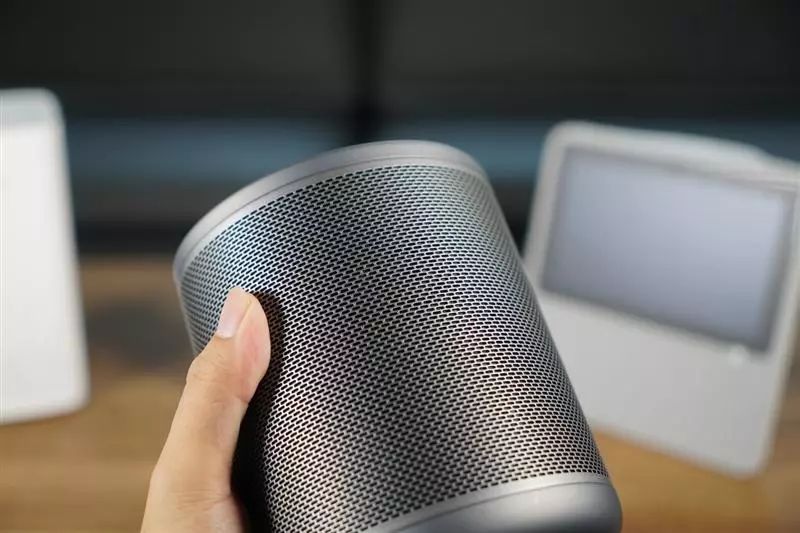
Xiao Bao AI Speaker has a front design that is quite different from most smart speakers which use fabric mesh covers; it is enveloped in a metal mesh that gives it a heft when held.
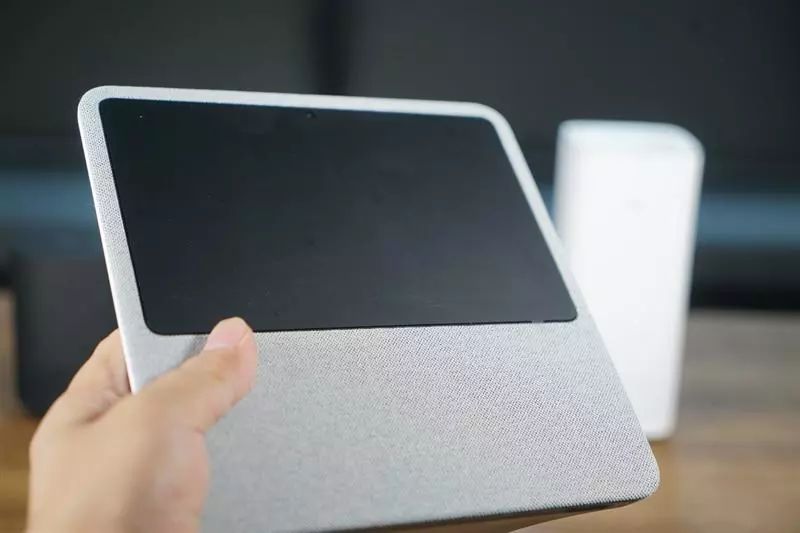
Baidu’s Home has a front design that, compared to other smart speakers, incorporates a dust mesh cover as one of its main design elements, covering all areas except the screen. The fabric texture provides an excellent visual and tactile experience, but such a large area of fabric also raises concerns about its durability against daily wear and tear.
It can be seen that the vast majority of smart speakers are made of plastic, while the Xiao Bao AI Speaker uses metal material.
3. Sound Quality Comparison: The Comparison Is Undoubtedly Clear—It Is the Sound Quality Champion Among Smart Speakers
For many enthusiasts, sound quality is a somewhat mystical concept. The popular joke about “fire electricity and water electricity” is not only a mockery of this craft but also reveals the overly subjective nature of human perception of sound.
However, this issue does not exist with smart speakers, as the overly simplistic hardware of most products leads to sound quality hovering at a level of “just enough to hear”, such as the Xiaomi AI Speaker and TMall Genie X1, both of which only have single speaker designs…
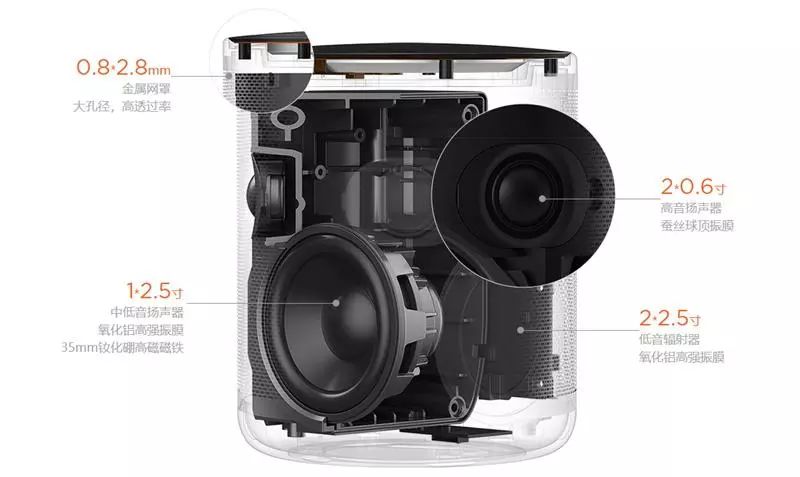
Among these four products, the Xiao Bao AI Speaker features a design with 2 0.6-inch tweeters, 1 2.5-inch woofer, and 2 passive radiators, totaling 5 speakers. The Xiao Bao AI Speaker also claims to be the “sound quality champion of the smart speaker world”.
So how do the actual performances of these four smart speakers compare? I selected three classic tracks: “Hotel California”, “One I Love”, and “Millennium Elegance” to test their performances.
1. Sound Quality Comparison
—”Hotel California”

“Hotel California” is a classic test track.
TMall Genie X1: Overall performance is average, with overly bland highs and lows causing some instruments to sound slightly muddled, occasionally overshadowing the vocals.
Xiao Bao AI Speaker: Thanks to its 5-speaker design, the bass is powerful, making it suitable for heavy bass or rock music, providing a strong sense of vibration.
Xiaomi AI Speaker: Highs and lows are not pronounced, with a relatively flat sound quality.
Baidu’s Home: Performs well with “Hotel California”, with clear separation between instruments and vocals.
—”One I Love”

This is a classic female vocal test track, ideal for testing the detail performance of headphones.
TMall Genie X1: The details of the female vocals are relatively rich, but the dynamics are not prominent, expressed in a straightforward manner.
Xiao Bao AI Speaker: The voice details are quite rich, with a noticeable transparency, crispness, and no barriers.
Xiaomi AI Speaker: Voice details are mostly restored but with no standout features, acceptable to the ear.
Baidu’s Home: Performs surprisingly well, with rich details in the female vocals and clear articulation.
—”Millennium Elegance”

“Millennium Elegance” by Zhou Zilei is a pure instrumental piece featuring the ocarina, which tests the resonance and extension of headphones.
TMall Genie X1: Performs adequately, with sufficient loudness and some low-frequency depth, but overall highs and lows are somewhat strained.
Xiao Bao AI Speaker: During playback, the initial drum sound shows a strong transient response, and its excellent low-frequency performance ensures that the ocarina’s resonance is well restored.
Xiaomi AI Speaker: As before, the performance hovers around the acceptable level, with a flat sound that fails to showcase the ocarina’s intricate resonance.
Baidu’s Home: Continues to perform well, with adequate transient response and excellent resonance handling.
During the sound quality comparison, there was a small incident. I originally selected the classic tracks “Crossing the River” and “Drum Poem” to test the performances of the four speakers, but Baidu’s Home did not have the rights to these tracks, which highlights the scarcity of some less mainstream music resources.
It can be seen that among the four speakers, Xiao Bao AI Speaker has the best sound quality, while Baidu’s Home also performs quite well, suitable for listening to mid-range female vocals, while TMall Genie X1 performs adequately, and Xiaomi AI Speaker is slightly inferior.
2. Speaker Loudness Comparison
Here we set all four speakers to 100% volume and played the same song to test loudness.

From top to bottom are TMall Genie X1 (around 103db), Xiao Bao AI Speaker (around 106db), Xiaomi AI Speaker (around 94db), and Baidu’s Home (around 99db).
It can be visually seen that the Xiao Bao AI Speaker, with its five-speaker design, has the highest loudness among the four smart speakers, followed by TMall Genie X1 and Baidu’s Home, while Xiaomi AI Speaker is the lowest.
3. Wake Distance Comparison
As a smart product operated by voice, the practicality is undoubtedly affected by the wake response rate, which involves two questions: how to wake it and how loud does it need to be to wake it.
The wake words for all four smart speakers are very simple, namely “TMall Genie”, “Xiao Bao Xiao Bao”, “Xiao Ai Tong Xue”, and “Xiao Du Xiao Du”. Having established the wake words, how loud does it need to be to wake them?
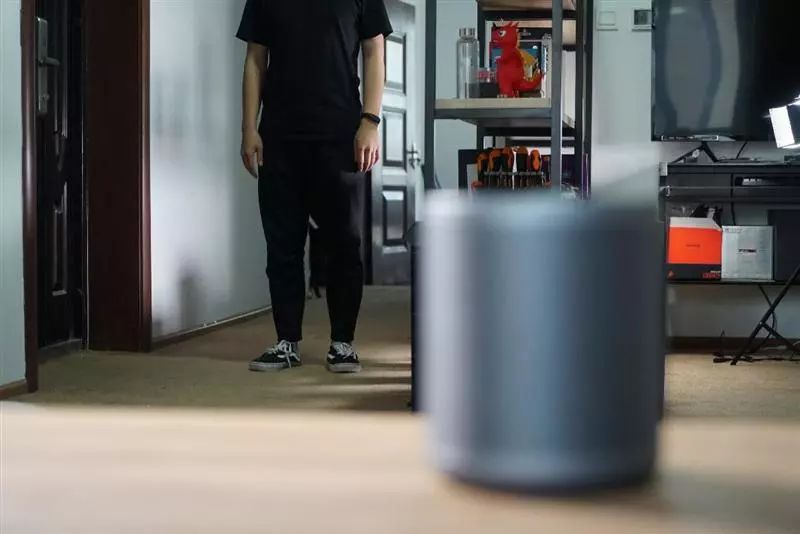
To test this, I conducted wake tests from distances of 1m, 3m, and 5m to see the minimum volume required to wake the speaker from different distances.
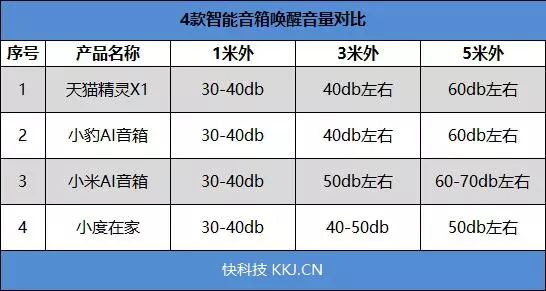
After testing, it was found that Baidu’s Home was the easiest to wake, with good reception, able to be activated from 5 meters away with a relatively quiet voice; Xiao Bao AI Speaker and TMall Genie X1 could be activated with normal volume from 5 meters away; while Xiaomi AI Speaker may require slightly louder volume to wake.
4. Experience Comparison: Each Speaker Shows Its Strengths, with Xiao Bao AI Speaker Dominating
All four speakers I have are equipped with different smart voice systems, among which TMall Genie X1 is equipped with Alibaba’s smart voice assistant AliGenie, Baidu’s Home uses Baidu’s own Duer OS.
As for Xiao Bao AI Speaker, it uses Cheetah Mobile’s self-developed Orion Voice OS. This name may not be familiar to everyone, but the well-known Xiaomi AI Speaker also uses Orion Voice OS’s TTS and ASR technology, and you can also find Orion Voice OS in the Xiaoya speaker on Ximalaya and the Xiaomei speaker from Midea.
Orion Voice OS is currently the most open system among smart speakers, and thanks to its openness, it has achieved impressive installation numbers, with over 10 million requests daily. In the future, manufacturers including Foxconn and Smartisan plan to launch smart products based on it.
So how is the system software experience for these four speakers?
1. Resource Comparison
—Music Resource Comparison
Although most smart speakers currently claim to have millions or even tens of millions of songs in their libraries, the most important thing is whether users can actually find the songs they love during their experience.
To this end, I conducted a simple comparison by selecting the 10 most popular new songs from the Chinese music charts to test the music resource availability of the four speakers (as of June 6, 2018).
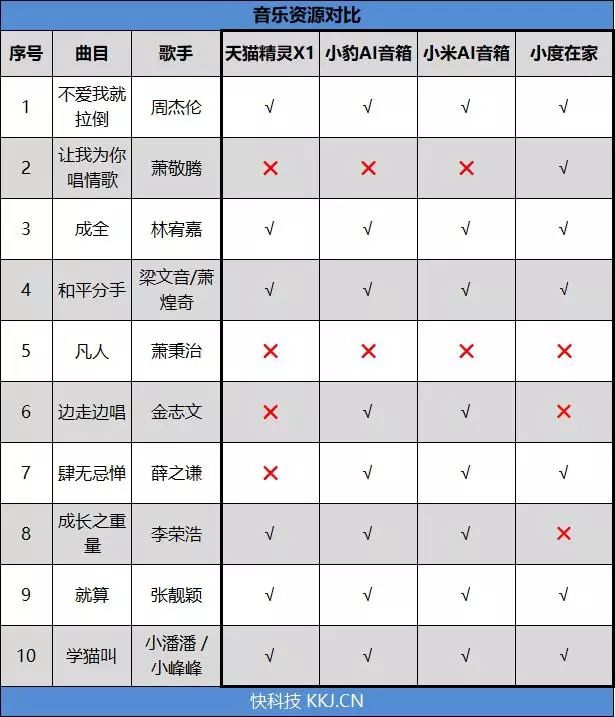
It can be seen that among these 10 songs, the Xiao Bao AI Speaker and Xiaomi AI Speaker could not find only 2 songs, while Baidu’s Home could not find 3 songs, and TMall Genie X1 had over 4 songs without copyright.
The availability of music resources undoubtedly depends on copyright. Both Xiao Bao AI Speaker and Xiaomi AI Speaker, using Orion Voice OS, are supported by QQ Music, the largest music copyright platform in China, so they naturally have more copyrighted music.
—Audio Resource Comparison
Similar to music resources, I selected 10 commonly listened audio resources, including crosstalk, storytelling, audiobooks, jokes, radio, children’s books, and English content, to test the richness of resources of the four speakers (as of June 6, 2018).
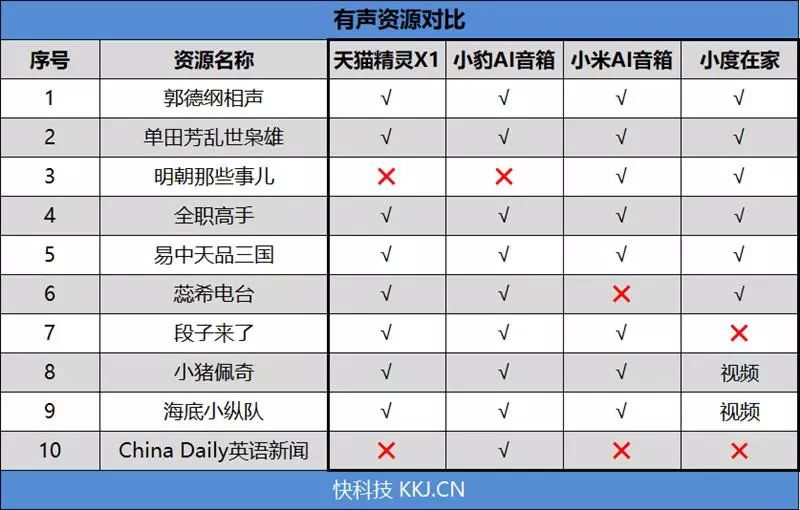
It can be seen that in the test of 10 categories of common audio resources, Xiao Bao AI Speaker maintained its resource advantage, passing 9 tests, while the other three speakers only passed 8 tests.
Additionally, it should be noted that many resources on Baidu’s Home are played in video format rather than audio.
2. Unique Features Introduction
Here, I will briefly introduce the exclusive features of TMall Genie X1, Xiao Bao AI Speaker, and Baidu’s Home.
—TMall Genie X1 and Taobao Shopping
As TMall Genie X1 is produced by Alibaba, it naturally facilitates user shopping. It supports Alipay voiceprint payment, allowing for voice payments. Specifically, TMall Genie X1 can implement voice top-ups, voice shopping (TMall Supermarket), and voice takeout ordering.
—Xiao Bao AI Speaker and WeChat Payment
Xiao Bao AI Speaker is the first smart speaker in China to support WeChat Payment, which is quite unexpected, as I initially thought this feature would appear first in Tencent’s smart speakers.

To complement the payment feature, Xiao Bao AI Speaker also has built-in voiceprint recognition, accurately identifying the speaker’s identity, making it one of the few smart speakers in China with this feature.
—Baidu’s Home Video Function
Baidu’s Home is a smart speaker launched in collaboration with Xiaoyu Home, a company specializing in remote video calling robots. With Xiaoyu’s help, Baidu’s Home not only serves as a smart speaker but also has remote video capabilities, allowing video calls via the Baidu Home app or direct phone number dialing, making it very convenient.
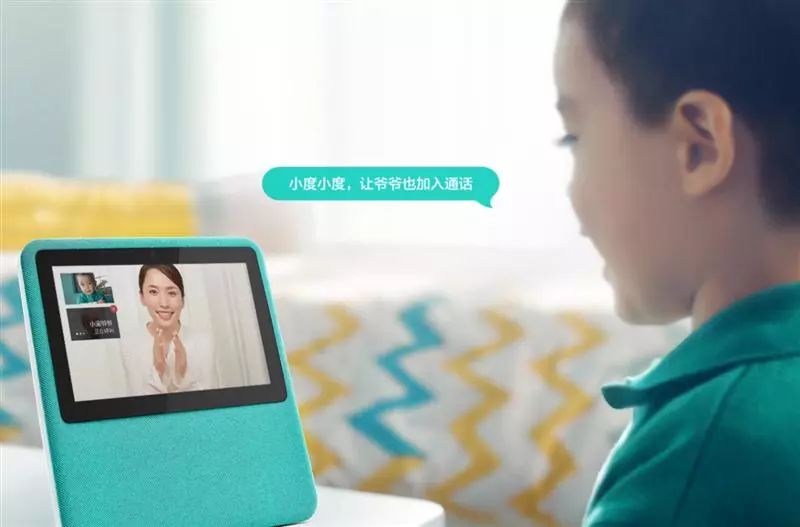
5. Power Consumption Comparison: Baidu’s Home Consumes the Most Power
Smart speakers, especially smart speakers, as an all-time online household appliance, need to be plugged in and connected to the internet 24/7, making power consumption very important. So how do the power consumption performances of these four smart speakers compare?
For comparison, I tested the power consumption of the four smart speakers in both standby mode and at 100% volume while playing music, as follows:
—Standby Power Consumption

From top to bottom are TMall Genie X1 (around 2-3W), Xiao Bao AI Speaker (around 2-3W), Xiaomi AI Speaker (around 2-2.5W), and Baidu’s Home (around 4-5W).
Without a doubt, the highest standby power consumption is Baidu’s Home, which has an additional screen, with standby power consistently exceeding 4W, while the other three speakers are around 2-3W.
Calculating, Baidu’s Home consumes one kilowatt-hour of electricity every 9 days (average of 4.5W); while the other three speakers consume one kilowatt-hour every 16 days (average of 2.5W). In terms of standby power consumption, TMall Genie X1, Xiao Bao AI Speaker, and Xiaomi AI Speaker are undoubtedly more energy-efficient.
—Power Consumption at 100% Volume Playing Music

From top to bottom are TMall Genie X1 (around 4W), Xiao Bao AI Speaker (around 4-5W), Xiaomi AI Speaker (around 3.5-4.5W), and Baidu’s Home (around 5-6W).
Baidu’s Home again takes the title of the most power-consuming smart speaker, while Xiaomi AI Speaker has the lowest power consumption due to its lower volume (94.5db).
6. Conclusion: Each of the Four Speakers Has Its Unique Features
Without further ado, let’s get to the conclusion. It is clear from the tests that the four smart speakers perform differently in terms of sound quality, volume, resources, and power consumption:
In terms of sound quality, the Xiao Bao AI Speaker undoubtedly earns five stars due to its hardware superiority, as five speakers outperform a single speaker, making this result expected. Xiao Bao AI Speaker lives up to its title as the sound quality champion.
As for the richness of music/audio resources, thanks to QQ Music, both Xiaomi AI Speaker and Xiao Bao AI Speaker have a decent amount of resources; while TMall Genie X1, backed by Alibaba, can meet daily needs with Xiami Music.
However, Baidu’s Home has a significant resource gap, as although it has a rich collection of new songs, many less mainstream music resources are often missing.
Regarding pricing, currently, the Xiaomi AI Speaker is priced at 299 yuan, TMall Genie X1 at 499 yuan, Baidu’s Home at 599 yuan, and Xiao Bao AI Speaker at 699 yuan.
The Xiaomi AI Speaker undoubtedly has the best price advantage, which is a consistent feature of Xiaomi products. The other three speakers increase in price by 100 yuan each, and there may be discounts during promotional periods, so keep an eye out.
These speakers each have their unique features, and it is necessary for readers to determine the product that best suits their actual needs.

For example, some users primarily use smart speakers to listen to music/audio resources and are willing to spend more money to meet their sound quality requirements, then Xiao Bao AI Speaker should be the most suitable smart speaker for you.
If some users do not use smart speakers frequently and only occasionally listen to music/audio resources for fun, then the well-known Xiao Ai Tong Xue (Xiaomi AI Speaker) might be more attractive to you.
On the other hand, TMall Genie X1 is likely more suitable for families with shopping needs, as it is backed by Alibaba, allowing for easy online shopping and takeout ordering.
If there are children or elderly people in the home who require communication, consider Baidu’s Home, as it resembles a remote video robot more than a traditional smart speaker.
All in all
This review serves as a science popularization
To provide a reference for everyone
On whether to buy, and which one to buy
Ultimately, just follow your heart.
– END –
(Source: Do News website, edited and compiled. Copyright notice: Articles promoted by the “China Industrial Design Association” will be attributed to the author and source unless it is impossible to confirm. If there are any copyright issues, please contact us to discuss solutions. Contact: 010-68209323)
